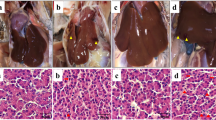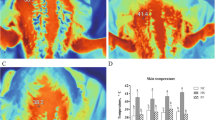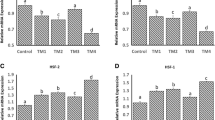Abstract
Fibroblasts produce collagen which is mainly essential for repairing tissue damage and maintaining the structural integrity of tissues. However, studies have given scientific evidence about harmful effect of thermal manipulation in fibroblast. Therefore, the aim of this study was to determine the mild heat stress temperature which increased broiler fibroblast viability. The experiment was divided into two groups (37 °C and 41 °C), and each group was divided into five subgroups based on different incubation times (6 h, 12 h, 24 h, 48 h, and 72 h) with three replications. In experimental group (41 °C), fibroblast viability increased significantly in 12 h but decreased in 72 h compared with control (37 °C). At 41 °C, live cell increased significantly in 24 h and then declined in 48 h as well as 72 h than control. Moreover, the S phase lengthened in shorter incubation time of experimental group compared with control. Protein and mRNA (HSP70, HSP60, and HSP47) expressions were significantly higher at 41 °C compared with 37 °C, but at the end of the experiment, HSP expression level was higher in both groups. Finally, this study recommended 41 °C as a mild heat stress temperature for increasing broiler fibroblast viability.







Similar content being viewed by others
References
Abdelnasir A, Sun JR, Cheng YF, Chen HB, Tang S, Kemper N, Hartung J, Bao ED (2014) Evaluation of Hsp47 expression in heat-stressed rat myocardial cells in vitro and in vivo. Genet Mol Res 13:10787–10802
Arjona AA, Denbow DM, Weaver WD Jr (1988) Effect of heat stress early in life on mortality of broilers exposed to high environmental temperatures just prior to marketing. Poult Sci 67:226–231
Arya R, Mallik M, Lakhotia SC (2007) Heat shock genes - integrating cell survival and death. J Biosci 32:595–610
Bang OS, Ha BG, Park EK, Kang SS (2000) Activation of Akt is induced by heat shock and involved in suppression of heat-shock-induced apoptosis of NIH3T3 cells. Biochem Biophys Res Commun 278:306–311
Belal SA, Sivakumar AS, Kang DR, Cho S, Choe HS, Shim KS (2018) Modulatory effect of linoleic and oleic acid on cell proliferation and lipid metabolism gene expressions in primary bovine satellite cells. Anim Cells Syst 22:324–333
Bose D, Chakrabarti A (2017) Substrate specificity in the context of molecular chaperones. IUBMB Life 69:647–659
Bukau B, Deuerling E, Pfund C, Craig EA (2000) Getting newly synthesized proteins into shape. Cell 101:119–122
Chen D, Toone WM, Mata J, Lyne R, Burns G, Kivinen K, Brazma A, Jones N, Bähler J (2003) Global transcriptional responses of fission yeast to environmental stress. Mol Biol Cell 14:214–229
Choudhery MS, Badowski M, Muise A, Harris DT (2015) Effect of mild heat stress on the proliferative and differentiative ability of human mesenchymal stromal cells. Cytotherapy 17:359–368
Desmoulière A, Redard M, Darby I, Gabbiani G (1995) Apoptosis mediates the decrease in cellularity during the transition between granulation tissue and scar. Am J Pathol 146:56–66
Ekambaram P (2001) HSP70 expression and its role in preeclamptic stress. Indian J Biochem Biophys 48:243–255
Fulda S, Gorman AM, Hori O, Samali A (2010) Cellular stress responses: cell survival and cell death. Int J Cell Biol 2010:214074
Gao CQ, Zhao YL, Li HC, Sui WG, Yan HC, Wang XQ (2015) Heat stress inhibits proliferation, promotes growth, and induces apoptosis in cultured Lantang swine skeletal muscle satellite cells. J Zhejiang Univ Sci B 16:549–559
Harding RL, Halevy O, Yahav S, Velleman SG (2016) The effect of temperature on proliferation and differentiation of chicken skeletal muscle satellite cells isolated from different muscle types. Physiol Rep 4:e12770
Hartl FU (1996) Molecular chaperones in cellular protein folding. Nature 381:571–579
Hartl FU, Hayer-Hartl M (2002) Molecular chaperones in the cytosol: from nascent chain to folded protein. Science 295:1852–1858
Horváth I, Multhoff G, Sonnleitner A, Vígh L (2008) Membrane-associated stress proteins: more than simply chaperones. Biochim Biophys Acta 1778:1653–1664
Ibtisham F, Zhao Y, Nawab A, Liguang H, Wu J, Xiao M, Zhao Z, An L (2018) The effect of high temperature on viability, proliferation, apoptosis and anti-oxidant status of chicken embryonic fibroblast cells. Braz J Poult Sci 20:463–470
Kalluri R, Zeisberg M (2006) Fibroblasts in cancer. Nat Rev Cancer 6:392–401
Kirchhoff SR, Gupta S, Knowlton AA (2002) Cytosolic heat shock protein 60, apoptosis, and myocardial injury. Circulation 105:2899–2904
Kühl NM, Rensing L (2000) Heat shock effects on cell cycle progression. Cell Mol Life Sci 57:450–463
Kültz D (2005) Molecular and evolutionary basis of the cellular stress response. Annu Rev Physiol 67:225–257
Li CY, Lee JS, Ko YG, Kim JI, Seo JS (2000) Heat shock protein 70 inhibits apoptosis downstream of cytochrome c release and upstream of caspase-3 activation. J Biol Chem 275:25665–25671
Li Y, Zhang P, Qiu F, Chen L, Miao C, Li J, Xiao W, Ma E (2012) Inactivation of PI3K/Akt signaling mediates proliferation inhibition and G2/M phase arrest induced by andrographolide in human glioblastoma cells. Life Sci 90:962–967
Li BJ, Li PH, Huang RH, Sun WX, Wang H, Li QF, Chen J, Wu WJ, Liu HL (2015) Isolation, culture and identification of porcine skeletal muscle satellite cells. Asian-Australas J Anim Sci 28:1171–1177
Lin RZ, Hu ZW, Chin JH, Hoffman BB (1997) Heat shock activates c-Src tyrosine kinases and phosphatidylinositol 3-kinase in NIH-3T3 fibroblasts. J Biol Chem 272:31196–31202
Livak KJ, Schmittgen TD (2001) Analysis of relative gene expression data using real-time quantitative PCR and the 2−ΔΔCT method. Methods 25:402–408
Mosser DD, Caron AW, Bourget L, Denis-Larose C, Massie B (1997) Role of the human heat shock protein hsp70 in protection against stress-induced apoptosis. Mol Biol Cell 17:5317–5327
Park HG, Han SI, Oh SY, Kang HS (2005) Cellular responses to mild heat stress. Cell Mol Life Sci 62:10–23
Parsonage G, Filer AD, Haworth O, Nash GB, Rainger GE, Salmon M, Buckley CD (2005) A stromal address code defined by fibroblasts. Trends Immunol 26:150–156
Reissis Y, García-Gareta E, Korda M, Blunn GW, Hua J (2013) The effect of temperature on the viability of human mesenchymal stem cells. Stem Cell Res Ther 4:139
Ribble D, Goldstein NB, Norris DA, Shellman YG (2005) A simple technique for quantifying apoptosis in 96-well plates. BMC Biotechnol 5:12. https://doi.org/10.1186/1472-6750-5-12
Ryan MT, Pfanner N (2002) Hsp70 proteins in protein translocation. Adv Protein Chem 59:223–242
Saleh A, Srinivasula SM, Balkir L, Robbins PD, Alnemri ES (2000) Negative regulation of the Apaf-1 apoptosome by Hsp70. Nat Cell Biol 2:476–483
Selye H (1976) Stress without distress. In: Psychopathology of Human Adaptation. Springer, Boston, MA, pp 137–146
Siddiqui SH, Subramaniyan SA, Kang D, Park J, Khan M, Shim K (2020) Modulatory effect of heat stress on viability of primary cultured chicken satellite cells and expression of heat shock proteins ex vivo. Anim Biotechnol:1–12. https://doi.org/10.1080/10495398.2020.1757460
Spatz MA (2004) Genetics home reference. J Med Libr Assoc 92:282–283
Srivastava P (2002) Roles of heat-shock proteins in innate and adaptive immunity. Nat Rev Immunol 2:185–194
Taguchi T, Razzaque MS (2007) The collagen-specific molecular chaperone HSP47: is there a role in fibrosis? Trends Mol Med 13:45–53
Tomasek JJ, Gabbiani G, Hinz B, Chaponnier C, Brown RA (2002) Myofibroblasts and mechano-regulation of connective tissue remodelling. Nat Rev Mol Cell Biol 3:349–363
Veereshwarayya V, Kumar P, Rosen KM, Mestril R, Querfurth HW (2006) Differential effects of mitochondrial heat shock protein 60 and related molecular chaperones to prevent intracellular beta-amyloid-induced inhibition of complex IV and limit apoptosis. J Biol Chem 281:29468–29478
Velazquez JM, Lindquist S (1984) hsp70: nuclear concentration during environmental stress and cytoplasmic storage during recovery. Cell 36:655–662
Velnar T, Bailey T, Smrkolj V (2009) The wound healing process: an overview of the cellular and molecular mechanisms. J Int Med Res 37:1528–1542
Yamaguchi T, Suzuki T, Arai H, Tanabe S, Atomi Y (2010) Continuous mild heat stress induces differentiation of mammalian myoblasts, shifting fiber type from fast to slow. Am J Physiol Cell Physiol 298:C140–C148
Yan J, Bao E, Yu J (2009) Heat shock protein 60 expression in heart, liver and kidney of broilers exposed to high temperature. Res Vet Sci 86:533–538
Yang SY, Hoy M, Fuller B, Sales KM, Seifalian AM, Winslet MC (2010) Pretreatment with insulin-like growth factor 1 protects skeletal muscle cells against oxidative damage via PI3K/Akt an ERK1/2 MAPK pathways. Lab Investig 90:391–401
Yeo SY, Lee KW, Shin D, An S, Cho KH, Kim SHA (2018) A positive feedback loop bi-stably activates fibroblasts. Nat Commun 9:3016
Acknowledgments
The authors would like to show gratitude to Jang-Ock Cha (Jeonbuk National University, Republic of Korea) for his assistance. We thank Yun-Young Choi, Center for University Research Facility (CURF) at Jeonbuk National University.
Funding
This work was supported by the Basic Science Research Program, through the National Research Foundation of Korea (NRF) funded by Ministry of Education (Project No. 2020R1I1A3A04038058).
Author information
Authors and Affiliations
Contributions
Conceived and designed this study: KSS and HWC. Performed the fibroblast isolation: SHS, SAS, DRK and JRP. Performed the experiments: SHS and MK. Analyzed the data: SHS and HWC. Manuscript writing: SHS. All authors read and approved final manuscript.
Corresponding authors
Ethics declarations
Compliance with ethical standards
All animal care and use were performed according to the ethical guidelines by the Ethics Committee of Chonbuk National University Laboratory Animal Center, and all experimental protocol was approved by the institution (approval number: CBNU2018-097).
Conflict of interest
The authors declare that they have no competing interests.
Additional information
Publisher’s note
Springer Nature remains neutral with regard to jurisdictional claims in published maps and institutional affiliations.
Rights and permissions
About this article
Cite this article
Siddiqui, S.H., Subramaniyan, S.A., Kang, D. et al. Direct exposure to mild heat stress stimulates cell viability and heat shock protein expression in primary cultured broiler fibroblasts. Cell Stress and Chaperones 25, 1033–1043 (2020). https://doi.org/10.1007/s12192-020-01140-x
Received:
Revised:
Accepted:
Published:
Issue Date:
DOI: https://doi.org/10.1007/s12192-020-01140-x




